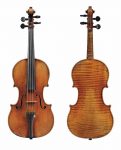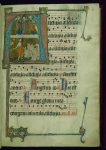Violins. The violin was first known in 16th-century Italy, with some further modifications occurring in the 18th and 19th centuries to give the instrument a more powerful sound and projection. In Europe, it served as the basis for the development of other stringed instruments used in Western classical music, such as the viola.
Violinists and collectors particularly prize the fine historical instruments made by the Stradivari, Guarneri, Guadagnini and Amati families from the 16th to the 18th century in Brescia and Cremona (Italy) and by Jacob Stainer in Austria. According to their reputation, the quality of their sound has defied attempts to explain or equal it, though this belief is disputed. Great numbers of instruments have come from the hands of less famous makers, as well as still greater numbers of mass-produced commercial “trade violins” coming from cottage industries in places such as Saxony, Bohemia, and Mirecourt. Many of these trade instruments were formerly sold by Sears, Roebuck and Co. and other mass merchandisers. Reference: Wikipedia
VIOLIN BELONGING TO ALBERT EINSTEIN. Violin with spruce top, maple sides, back and neck, carved scroll headstock, 1933, inscribed inside: “Made for the Worlds[sic] Greatest Scientist Profesior[sic] Albert Einstein By Oscar H. Steger, Feb 1933 / Harrisburg, PA,” approximately 600 x 185 mm, contained in hardshell case with unmarked bow. With vintage postcard of Einstein playing a violin. Provenance: Oscar H. Steger to Albert Einstein; Einstein to Lawrence Wilson Hibbs, son of Princeton janitor/handyman Sylas Hibbs; by descent to present owner.
Einstein began playing the violin at age 6, but it wasn’t until the age of 13, when he discovered the Mozart violin sonatas, that music became a passion for him. His second wife Elsa was quoted: “Music helps him when he is thinking about his theories. He goes to his study, comes back, strikes a few chords on the piano, jots something down, returns to his study.” Einstein rarely traveled without his violin and music was so important that he would arrange his schedule so that he could host a weekly Wednesday night chamber music session in his Princeton home. In October 1933, Einstein had just arrived in the U.S. to accept a post as a resident scholar at the Princeton Institute for Advance Study, escaping the worsening situation for Jewish intellectuals in Nazi Germany. As the one of the most prominent intellectuals of the time, his arrival was a cause for celebration in America. Cabinet maker and member of the Harrisburg Symphony Orchestra Oscar H. Steger was moved to craft a violin, which he presented to the professor shortly after his arrival. The gift was covered in two Harrisburg newspapers of the time, on October 25th and 26th.
Sold for US$ 516,500 (£ 411,470) inc. premium at Bonhams in 2018
European violin, made of wood, with darker wood for the fingerboard, f-holes, scroll and four pegs; missing the strings, bridge, tailpiece and chinrest. A thin inlaid strip around edge on both sides, of paler wood bordered by darker wood. The peg heads with mother-of-pearl pins at the ends.
Reference: © The Trustees of the British Museum
JEAN BAPTISTE VUILLAUME A VIOLIN, PARIS, CIRCA 1850 Labeled Jean Baptiste Vuillaume à Paris Rue Croix des Petits Champs, length of back: 14 in. (356 mm) with case
Sold for USD 98,500 at Christie’s in 2012
Violin Bearing Label for Andreas Hoyer, Violin Maker, Klingenthal, 1776 In case. Bearing Label for Andreas Hoyer, Violin Maker, Klingenthal, 1776 In case.
Sold for $900 (includes buyer’s premium) at Doyle New York in 2006
“The Gould” Violin,1693 Antonio Stradivari Italian “The Gould” violin has a two-piece maple back with a tight flame and a two-piece spruce top with an orange-brown varnish. Although modern performers continue to use seventeenth- and eighteenth-century stringed instruments by great makers, nearly all of the instruments have been modified in order to remain useful as performance spaces grew larger and repertoire pushed instruments to create louder sound over an extended range. In 1975, The Metropolitan Museum had the luthier Frederick J. Lindeman of Amsterdam modify “The Gould” so that it would be in a Baroque configuration. He based his alterations on what was known of historical setups from the late seventeenth century, specifically he patterned the fingerboard and tailpiece after surviving original examples on the 1690 “Tuscan-Medici” Strad housed at the Accademia in Florence. Lindeman also fashioned a shorter neck and bassbar and fitted the instrument with a new soundpost, bridge, and pegs, as well as stringing it in gut. “The Gould” is the only violin by the famed master that has been returned to a Baroque setup and that is regularly used for performance of period repertoire.
Reference: The Metropolitan Museum of Art






